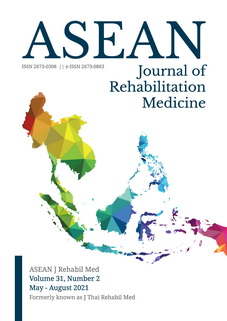A Comparison of Gait Analysis and Amputee Satisfaction and Acceptability between the CU Polycentric Knee Unit and the Four-Bar Linkage Knee Unit in Transfemoral Amputees: A Pilot Randomized Crossover Study
Keywords:
gait analysis, amputees, artificial limbs, knee prosthesisAbstract
Objectives: To compare the spatiotemporal gait parameters and satisfaction of transfemoral amputees using a prosthesis with Chulalongkorn University (CU) polycentric and four-bar linkage knee units.
Study design: A pilot randomized, crossover design.
Setting: Department of Rehabilitation Medicine, King Chulalongkorn Memorial Hospital, Thailand.
Subjects: Transfemoral amputees using a prosthesis in daily life
Methods: Participants were randomly allocated by block randomization into 2 groups. The knee unit of prostheses used in both groups was changed to the CU polycentric and four-bar linkage knee units but in different sequences. Gait parameters were analyzed by using gait analysis when walking at a comfortable speed.
Results: Of the 10 participants, 80 percent were classified as K3 level of functional classification. The mean duration of amputation was 24 years (SD 16) years and mean daily prosthesis use was 6.8 (SD 2.1) hours. There was not a significant difference in gait speed, step length, and cadence of prosthesis side and contralateral side (p > 0.05) between the two knee units. However, double limb support time when using the CU polycentric knee unit was statistically significant longer than using the four-bar linkage knee unit (mean difference 0.05 second, 95%CI 0.003- 0.100, p = 0.04). Amputee satisfaction level and perception of knee stability showed no significant difference between knee units.
Conclusion: Using the CU polycentric knee unit seems feasible and acceptable for K2-K3 transfemoral amputees. However, further development and testing are required before use in clinical practice.
Keywords: gait analysis, amputees, artificial limbs, knee prosthesis
References
Lovegreen W, Murphy DP, Smith WK. Lower limb amputation and gait. In: Cifu DX, editor. Braddom’s Physical medicine and rehabilitation. 5th ed. Philadelphia: Elsevier Health Sciences; 2015. p. 191-224.
Walsh NE, Bosker G, Maria DS. Upper and lower extremity prosthetics. In: Frontera WR, DeLisa JA, editors. DeLisa’s Physical medicine & rehabilitation: principles and practice. 5th ed. Philadelphia: Wolters Kluwer/Lippincott Williams & Wilkins Health, 2010. p. 2017-50
Wilken JM, Marin R. Gait analysis and training of people with limb loss. In: Pasquina P, Cooper RA, editors. Care of the combat amputee. Washington, DC: Office of the Surgeon General at TMM Publications, Borden Institute, Walter Reed National Military Medical Center; 2009. p. 535-52.
Gard SA, Childress DS, Uellendahl JE. The influence of four-bar linkage knees on prosthetic swing-phase floor clearance. J Prosthet Orthot. 1996;8:34-40.
Charoenboonvivat S. Design of knee joint mechanism for leg prosthesis [dissertation/ MSc]. Bangkok: Chulalongkorn University; 2010.
Lapapong S, Sucharitpwatskul S, Pitaksapsin N, Srisurangkul C, Lerspalungsanti S, Naewngerndee R, et al. Finite element modeling and validation of a four-bar linkage prosthetic knee under static and cyclic strength tests. J Assistive Rehabil Ther Technol. 2014;2:23211.
United States Health Care Financing Administration. Healthcare common procedure coding system. In: US Department of Health and Human Services, editor. Washington DC: 2001.
Barr JB, Wutzke CJ, Threlkeld AJ. Longitudinal gait analysis of a person with a transfemoral amputation using three different prosthetic knee/foot pairs. Physiother Theory Pract. 2012;28:407-11.
Esquenazi A.Gait analysis in lower-limb amputation and prosthetic rehabilitation. Phys Med Rehabil Clin N Am. 2014;25:153-67.
Kaufman KR, Frittoli S, Frigo CA.Gait asymmetry of transfemoral amputees using mechanical and microprocessor-controlled prosthetic knees. Clin Biomech. 2012;27:460-5.
Bohannon RW, Glenney SS. Minimal clinically important difference for change in comfortable gait speed of adults with pathology: a systematic review. J Eval Clin Pract. 2014;20:295-300.
Highsmith MJ, Andrews CR, Millman C, Fuller A, Kahle JT, Klenow TD, et al. Gait training interventions for lower extremity amputees: a systematic literature review. Technol Innov. 2016;18:99.
Sensinger JW, Intawachirarat N, Gard SA.Contribution of prosthetic knee and ankle mechanisms to swing-phase foot clearance. IEEE Trans Neural Syst Rehabil Eng. 2012;21:74-80.
Noble JW, Prentice SD. Adaptation to unilateral change in lower limb mechanical properties during human walking. Exp Brain Res. 2006;169:482-95.
English RD, Hubbard WA, McElroy GK.Establishment of consistent gait after fitting of new components. J Rehabil Res Dev. 1995; 32:32-5.
Downloads
Published
How to Cite
Issue
Section
License
Copyright (c) 2021 ASEAN Journal of Rehabilitation Medicine

This work is licensed under a Creative Commons Attribution-NonCommercial-NoDerivatives 4.0 International License.






